This is an AI Free Zone! Text created by Large Language Models is spreading rapidly across the Internet. It's well-written, artificial, frequently inaccurate. If you find a mistake on Spaceweather.com, rest assured it was made by a real human being. | | |
UNEXPECTED CME IMPACT: A CME hit Earth's magnetic field on June 15th (1157 UT). The unexpected impact sparked a minor G1-class geomagnetic storm, which has subsided but could flare up again on June 16th as Earth moves through the CME's wake. Aurora alerts: SMS Text
A POTENTIALLY DANGEROUS SUNSPOT: Only a few days ago, sunspot AR3712 didn't exist. Now it's 8 times wider than Earth and growing fast. Yesterday in Austria, Michael Karrer photographed the sunspot crackling with activity:
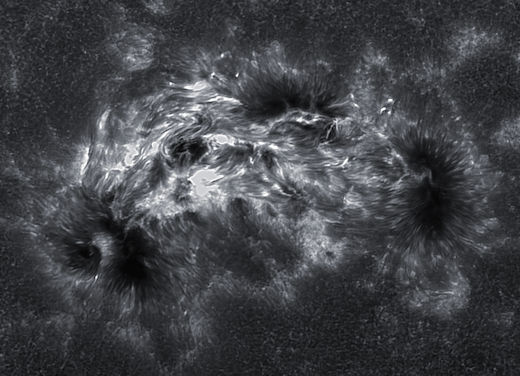
Karrer's photo reveals hot currents of plasma surging up and down the sunspot's massive backbone. A few hotspots are "Ellerman Bombs"-- magnetic explosions about one-millionth as powerful as true solar flares. A single Ellerman bomb releases about 1026 ergs of energy, equal to about 100,000 World War II atomic bombs.
Magnetograms of the sunspot reveal a mixed-polarity magnetic field with north (+) and south (-) poles bumping together. Magnetic reconnection could soon cause an X-class solar flare. Any such eruption this weekend will be geoeffective as the sunspot is turning to directly face Earth. Solar flare alerts: SMS Text
more images: from Philip Smith of Manorville, NY; from Philippe Tosi of Nîmes, France; from Ronnie Sherrill of Statesville, NC;
Realtime Space Weather Photo Gallery
Free: Spaceweather.com Newsletter
NOCTILUCENT CLOUDS IN MOTION: As the summer solstice approaches, noctilucent clouds (NLCs) are spreading across Europe. There's one surefire way to know when you've seen one--the electric-blue ripples. Michael Jaeger photographed them on June 14th over Martinsberg, Austria:
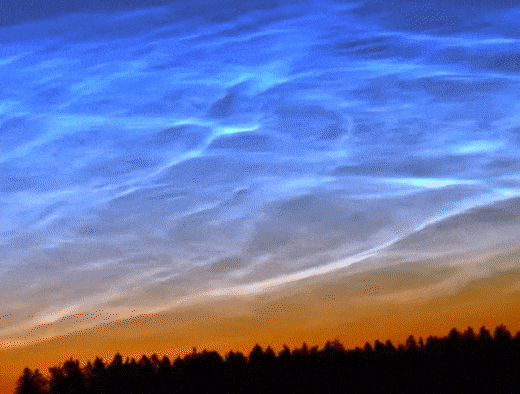
"This is a 2 minute animation of the night-shining clouds just after midnight," says Jaeger.
NLCs are clouds of frosted meteor smoke 83 km above Earth's surface. They form at this time of year when summertime wisps of water vapor rise to the mesosphere, coating specks of disintegrated meteoroids with an icy rime. The ripples are gravity waves.
Gravity waves are waves of pressure and temperature that ripple upward from powerful storm systems. They get their name from the fact that gravity acts as a restoring force, which tries to restore equilibrium to up-and-down moving air. Gravity waves can propagate all the way from Earth's surface to the mesosphere, where they imprint themselves on the the forms of noctilucent clouds.
If you see these waves rippling across the night sky, photograph them! Then, submit your images here.
Realtime Noctilucent Cloud Photo Gallery
Free: Spaceweather.com Newsletter
HANDMADE TOTAL ECLIPSE PENDANT: On April 8, 2024, the students of Earth to Sky Calculus launched a cosmic ray research balloon to the stratosphere. This handmade pendant went along for the ride. Floating more than 118,110 feet high, the it spent 3 minutes and 45 seconds wrapped in the shadow of the Moon:
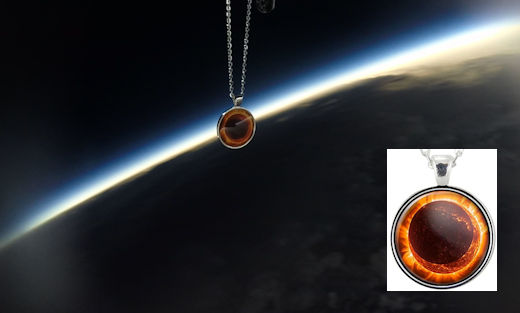
You can have it for $179.95. Created by an artist in Texas where totality occured, the pendant displays a solar eclipse art print sealed under a smooth glass cover. It comes with a greeting card showing the pendant in flight and telling the story of its journey to the edge of space during the total eclipse.
Far Out Gifts: Earth to Sky Store
All sales support hands-on STEM education
Realtime Comet Photo Gallery
Free: Spaceweather.com Newsletter
Realtime Aurora Photo Gallery
Free: Spaceweather.com Newsletter
Every night, a network of
NASA all-sky cameras scans the skies above the United States for meteoritic fireballs. Automated software maintained by NASA's Meteoroid Environment Office calculates their orbits, velocity, penetration depth in Earth's atmosphere and many other characteristics. Daily results are presented here on Spaceweather.com.
On Jun 15, 2024, the network reported 10 fireballs.
(10 sporadics)
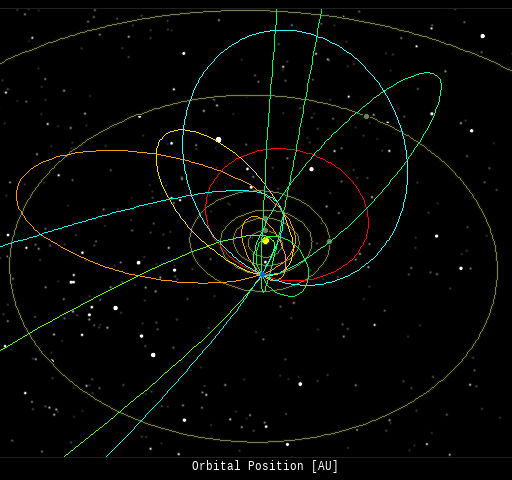
In this diagram of the inner solar system, all of the fireball orbits intersect at a single point--Earth. The orbits are color-coded by velocity, from slow (red) to fast (blue). [Larger image] [movies]
Potentially Hazardous Asteroids (
PHAs) are space rocks larger than approximately 100m that can come closer to Earth than 0.05 AU. None of the known PHAs is on a collision course with our planet, although astronomers are finding
new ones all the time.
On June 16, 2024 there were 2349 potentially hazardous asteroids.
 |
Recent & Upcoming Earth-asteroid encounters: | Asteroid | Date(UT) | Miss Distance | Velocity (km/s) | Diameter (m) |
| 2024 CR9 | 2024-Jun-11 | 19.2 LD | 7.4 | 451 |
| 2024 LD | 2024-Jun-11 | 12.1 LD | 10.7 | 21 |
| 2024 LV2 | 2024-Jun-11 | 12.3 LD | 28.2 | 77 |
| 2022 XC1 | 2024-Jun-12 | 16.5 LD | 6.5 | 21 |
| 2024 LQ5 | 2024-Jun-12 | 1.2 LD | 13.1 | 38 |
| 2024 LS5 | 2024-Jun-13 | 6.4 LD | 16.5 | 22 |
| 2024 LR5 | 2024-Jun-14 | 3.9 LD | 5.9 | 8 |
| 2024 LZ2 | 2024-Jun-14 | 3.5 LD | 20.4 | 20 |
| 2024 LL1 | 2024-Jun-15 | 5.2 LD | 9.2 | 21 |
| 2024 LS4 | 2024-Jun-15 | 11.1 LD | 4.8 | 23 |
| 2024 LZ4 | 2024-Jun-16 | 0.7 LD | 21.4 | 22 |
| 2024 LB4 | 2024-Jun-16 | 7.6 LD | 7.6 | 29 |
| 2024 LH3 | 2024-Jun-16 | 13 LD | 6.1 | 48 |
| 2024 LU1 | 2024-Jun-17 | 4.8 LD | 7.1 | 23 |
| 2022 WW11 | 2024-Jun-17 | 19.7 LD | 14.4 | 15 |
| 2024 KW1 | 2024-Jun-17 | 19.9 LD | 4 | 28 |
| 2024 KY1 | 2024-Jun-19 | 16.1 LD | 12.2 | 36 |
| 2024 LO3 | 2024-Jun-20 | 1.9 LD | 8 | 20 |
| 2024 LG5 | 2024-Jun-21 | 6.1 LD | 7.6 | 16 |
| 2024 LO2 | 2024-Jun-21 | 14.2 LD | 9.2 | 29 |
| 2024 LJ | 2024-Jun-22 | 8.8 LD | 18.5 | 69 |
| 2024 KN1 | 2024-Jun-23 | 14.6 LD | 4.6 | 28 |
| 2024 KJ | 2024-Jun-25 | 13.7 LD | 4.5 | 25 |
| 2024 LO5 | 2024-Jun-25 | 5.1 LD | 7.9 | 20 |
| 2019 NJ | 2024-Jun-27 | 17.2 LD | 10.1 | 66 |
| 415029 | 2024-Jun-27 | 17.3 LD | 25.9 | 2304 |
| 2022 MM1 | 2024-Jun-28 | 7.8 LD | 10.9 | 39 |
| 2010 XN | 2024-Jun-28 | 14.1 LD | 11.3 | 52 |
| 2022 HD1 | 2024-Jun-29 | 17.3 LD | 7.2 | 63 |
| 2017 MB3 | 2024-Jun-30 | 5 LD | 6.5 | 30 |
| 2024 JJ25 | 2024-Jun-30 | 10.5 LD | 9.4 | 117 |
| 2024 LJ2 | 2024-Jul-01 | 19.9 LD | 10.4 | 87 |
| 2022 BY39 | 2024-Jul-02 | 13.2 LD | 3 | 4 |
| 2024 LH | 2024-Jul-02 | 4.4 LD | 4.3 | 32 |
| 2024 KQ1 | 2024-Jul-04 | 14.9 LD | 6.9 | 57 |
| 2022 YS5 | 2024-Jul-11 | 11 LD | 5.8 | 38 |
| 2024 BY15 | 2024-Jul-16 | 16.2 LD | 0.7 | 16 |
| 2024 LY2 | 2024-Jul-23 | 12 LD | 7.8 | 88 |
| 2011 MW1 | 2024-Jul-25 | 10.1 LD | 8 | 120 |
| 2011 AM24 | 2024-Jul-26 | 16.8 LD | 6.2 | 281 |
| 523664 | 2024-Jul-28 | 14.9 LD | 23.7 | 680 |
| 2020 PN1 | 2024-Aug-02 | 18 LD | 5.5 | 29 |
| 2023 HB7 | 2024-Aug-05 | 14.6 LD | 6.1 | 32 |
| 2017 TU1 | 2024-Aug-05 | 10.1 LD | 10.1 | 22 |
| 2024 KH3 | 2024-Aug-10 | 14.5 LD | 11.4 | 194 |
Notes: LD means "Lunar Distance." 1 LD = 384,401 km, the distance between Earth and the Moon. 1 LD also equals 0.00256 AU. | | Cosmic Rays in the Atmosphere |
SPACE WEATHER BALLOON DATA: Almost once a week, Spaceweather.com and the students of Earth to Sky Calculus fly space weather balloons to the stratosphere over California. These balloons are equipped with sensors that detect secondary cosmic rays, a form of radiation from space that can penetrate all the way down to Earth's surface. Our monitoring program has been underway without interruption for 7 years, resulting in a unique dataset of in situ atmospheric measurements.
Latest results (July 2022): Atmospheric radiation is decreasing in 2022. Our latest measurements in July 2022 registered a 6-year low:
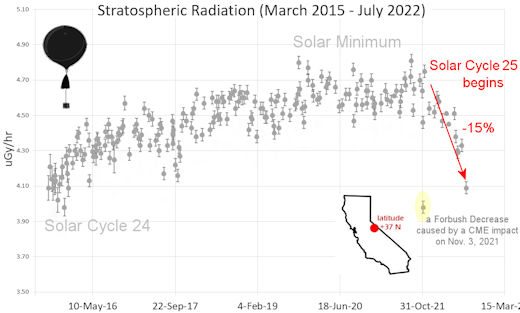
What's going on? Ironically, the radiation drop is caused by increasing solar activity. Solar Cycle 25 has roared to life faster than forecasters expected. The sun's strengthening and increasingly tangled magnetic field repels cosmic rays from deep space. In addition, solar coronal mass ejections (CMEs) sweep aside cosmic rays, causing sharp reductions called "Forbush Decreases." The two effects blend together to bring daily radiation levels down.
.Who cares? Cosmic rays are a surprisingly "down to Earth" form of space weather. They can alter the chemistry of the atmosphere, trigger lightning, and penetrate commercial airplanes. According to a study from the Harvard T.H. Chan school of public health, crews of aircraft have higher rates of cancer than the general population. The researchers listed cosmic rays, irregular sleep habits, and chemical contaminants as leading risk factors. A number of controversial studies (#1, #2, #3, #4) go even further, linking cosmic rays with cardiac arrhythmias and sudden cardiac death.
Technical notes: The radiation sensors onboard our helium balloons detect X-rays and gamma-rays in the energy range 10 keV to 20 MeV. These energies span the range of medical X-ray machines and airport security scanners.
Data points in the graph labeled "Stratospheric Radiation" correspond to the peak of the Regener-Pfotzer maximum, which lies about 67,000 feet above central California. When cosmic rays crash into Earth's atmosphere, they produce a spray of secondary particles that is most intense at the entrance to the stratosphere. Physicists Eric Regener and Georg Pfotzer discovered the maximum using balloons in the 1930s and it is what we are measuring today.
| | The official U.S. government space weather bureau |
| | The first place to look for information about sundogs, pillars, rainbows and related phenomena. |
| | Researchers call it a "Hubble for the sun." SDO is the most advanced solar observatory ever. |
| | 3D views of the sun from NASA's Solar and Terrestrial Relations Observatory |
| | Realtime and archival images of the Sun from SOHO. |
| | information about sunspots based on the latest NOAA/USAF Active Region Summary |
| | current counts of failed and deployed Starlink satellites from Jonathan's Space Page. See also, all satellite statistics. |
| | Authoritative predictions of space junk and satellite re-entries |
| | from the NOAA Space Environment Center |
| | fun to read, but should be taken with a grain of salt! Forecasts looking ahead more than a few days are often wrong. |
| | from the NOAA Space Environment Center |
| | the underlying science of space weather |
 | Got a chipped or cracked windshield that prevents you from seeing space weather events while driving? Get windshield replacement from SR Windows & Glass with free mobile auto glass service anywhere in the Phoenix area. |
 | Marketing yourself on YouTube is hard without real organic views on your videos. You can buy organic YouTube views from and enjoy social boosting that is actually real. Highly recommended! |
 | BestCSGOGambling is the best site for everything related to CSGO gambling on the web |
| | These links help Spaceweather.com stay online. Thank you to our supporters! |
| | | | | | |

